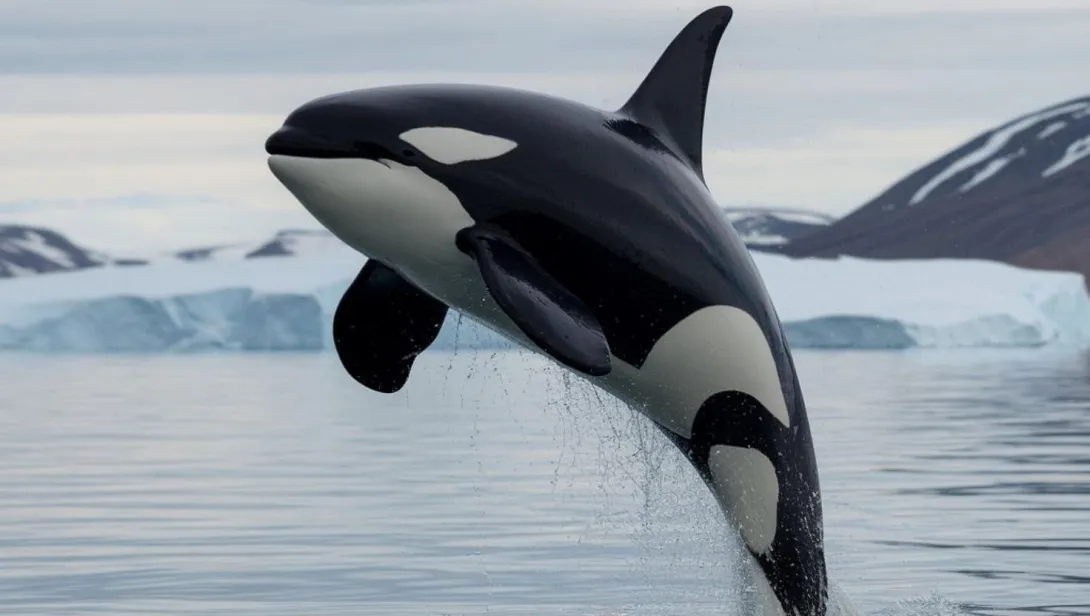Skip to main content
About Orca Whales
Introduction
- The Orca Whale (Orcinus orca), also known as the Killer Whale, is the largest member of the dolphin family (Delphinidae).
- They are known for their intelligence, social behavior, and striking black-and-white coloration.
- Orcas are apex predators, found in oceans worldwide, from the Arctic to the Antarctic.
Physical Characteristics
- Orcas have a robust, streamlined body, with males reaching lengths of up to 32 feet (9.8 meters) and weights of up to 10 tons (9 metric tons).
- Their skin is black with white patches on the underside, around the eyes, and behind the dorsal fin.
- They have a large dorsal fin, which can grow up to 6 feet (1.8 meters) tall in males, and pectoral fins for steering.
- Orcas have sharp, conical teeth that can number up to 56, used for gripping and tearing prey.
Habitat and Distribution
- Orcas are found in oceans worldwide, from polar regions to tropical seas.
- They inhabit both coastal and open ocean environments, often favoring colder waters.
- Orcas are highly adaptable and can thrive in a variety of marine habitats.
Diet and Hunting
- Orcas are apex predators and have a diverse diet, including fish, seals, sea lions, dolphins, and even large whales.
- They are highly skilled hunters, using teamwork and complex strategies to catch prey.
- Orcas use echolocation to locate prey, emitting high-frequency sounds that bounce off objects and return as echoes.
- Some populations specialize in hunting specific prey, such as salmon or marine mammals.
Behavior and Communication
- Orcas live in highly social groups called pods, which can range from a few individuals to over 40.
- They communicate through vocalizations such as clicks, whistles, and pulsed calls, which are unique to each pod.
- Orcas are known for their playful behavior, including breaching, spy-hopping, and tail-slapping.
- They are intelligent and have been observed using tools, such as sponges to protect their snouts while foraging.
Reproduction and Lifespan
- Female Orcas give birth to one calf after a gestation period of about 15 to 18 months.
- Calves are born weighing around 400 pounds (180 kg) and are 8 feet (2.4 meters) long.
- Calves nurse for 1 to 2 years but may stay with their mothers for life, forming strong family bonds.
- Orcas have a lifespan of 50 to 80 years, with females often living longer than males.
Conservation Status
- Orcas are classified as Data Deficient on the IUCN Red List, as some populations are endangered while others are stable.
- They are threatened by pollution, habitat loss, prey depletion, and captivity.
- Conservation efforts include protected marine areas, pollution control, and public awareness campaigns.
Unique Adaptations
- Orcas have echolocation, which allows them to navigate and hunt in dark or murky waters.
- Their black-and-white coloration provides camouflage, making them harder to see from above or below.
- They have a complex brain with a highly developed cerebral cortex, associated with intelligence and problem-solving.
- Orcas are highly adaptable, with different populations specializing in different prey and hunting techniques.
Cultural Significance
- Orcas are revered in many cultures as symbols of strength, intelligence, and family bonds.
- They are featured in mythology, literature, and art across the world, often representing power and mystery.
- In some Indigenous cultures, Orcas are considered spiritual guides and protectors of the ocean.
Fun Facts
- Orcas are the largest members of the dolphin family and are often called "wolves of the sea" due to their hunting prowess.
- They can swim at speeds of up to 34 mph (56 km/h), making them one of the fastest marine mammals.
- Orcas have unique dialects within their pods, which are passed down through generations.
- They are keystone species, playing a crucial role in maintaining the balance of marine ecosystems.
- Orcas have been observed teaching hunting techniques to their young, showcasing their intelligence and social bonds.
- They are highly curious and have been known to interact with boats and humans in the wild.
Threats to Orcas
- Pollution, including chemical runoff and plastic waste, poses a significant threat to Orcas.
- Prey depletion due to overfishing affects their ability to find food.
- Habitat destruction from coastal development and noise pollution disrupts their natural behaviors.
- Captivity in marine parks has been criticized for its impact on Orca health and well-being.
Conservation Efforts
- Marine protected areas have been established to safeguard Orca habitats and reduce human impact.
- Pollution control measures aim to reduce the amount of toxins entering the ocean.
- Public awareness campaigns educate people about the importance of Orca conservation.
- Research and monitoring programs track Orca populations and behaviors to inform conservation strategies.
